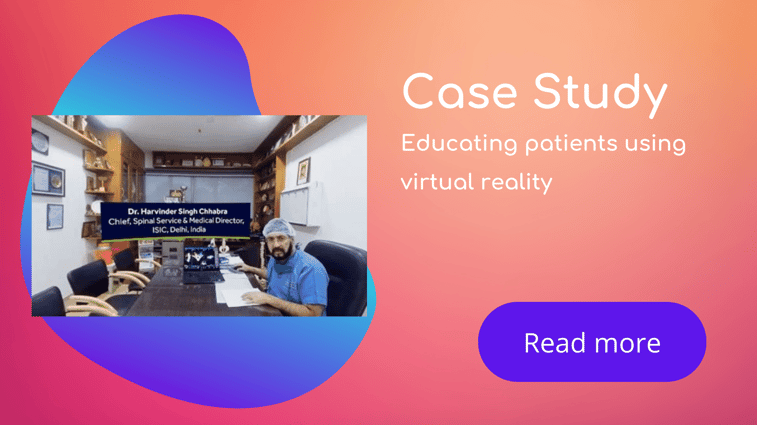Technology-driven patient enablement aids health and healing
'What if I do not wake up at all? Or, worse, wake up paralyzed?' was something a patient (to undergo surgery) was continuously thinking about.
The surgery was routine; the patient was young and educated, but the anxiety was not escaping. The surgeon and the anesthetist had visited him and assured him everything would go well. They were friendly and highly recommended, but the patient thought they were simply being polite despite their busy schedule.
The patient wished he could go inside his body and see the section that the surgeon was about to remove. Of course, the surgeon was very reputed, but he hoped he could be around to ensure nothing else inside his body was touched. Also, he innately wished to travel ahead in time and reassure himself that he would function normally after recovery.
Modern technology has made it possible for patients to virtually see their own body and comprehend surgical procedures. It has also allowed patients to understand how they would function more efficiently post-surgery.
Here the blog highlights how technology-driven information with Virtual Reality education can empower patients to make rational decisions about their bodies and health besides reducing pain and anxiety.
- Tackling dilemma with VR medical training
- VR medical education – a futuristic remedy
- Ethosh aiding efficient patient education
Tackling dilemma with VR medical training
"Don't worry, you'll be fine!" is something most patients get to hear, especially those about to undergo surgery. However, anxiety (mainly fueled by the lack of information) is natural and affects health and outcomes.
In their quasi-experimental study, Gursoy et al(1) found that preoperative stress was due to multiple fears, including the unknown, anesthesia, operative room environment, and complications. Another study by King et al(2) traced the source of preoperative anxiety to the surgery, complications, symptoms, recovery, organization, and provision of care.
There have also been many studies on the effect of counseling and simple education on the patient's state of mind and medical outcome.
Like, the lack of awareness about glaucoma among patients was a barrier to timely diagnoses and treatment. So, doctors opted for an interactive AR-based app as a visual aid for patient education.
In one study(3), two groups of patients were compared, one of whom had undergone formal counseling before surgery. The mean self-rating anxiety scale (SAS) score in this study group decreased after surgery from 51.5±4.3 to 45.1±6.5 (p=0.02), whereas the mean SAS score in the control group increased from 50.5±5.4 to 58.5±7.3 (p=0.03). The proportion of patients with anxiety symptoms in the control group was higher than in the study group following the surgery (58.3% vs. 33.3%, p=0.001).
Apart from managing anxiety, studies have also recorded the impact of information (counseling) on the duration of hospital stay, need for medication, and the rate of recovery.
While many medical professionals are also excellent counselors, the problem they face is time, especially in countries with insufficient resources. When they are hard-pressed to do justice to performing and upgrading their core skill, how can they be realistically expected to manage the time to sit around and counsel? Not surprisingly, forms that have more legalese than compassion continue to rule.
VR medical education – a futuristic remedy
Besides providing a realistic picture before the patient commits to a procedure, AR and VR training solutions have already found application in resolving several psychosocial issues. Thus aiding patients to make an educated decision regarding health and healing.
Technology-driven patient enablement benefits in handling stress and pain before, during, or after uncomfortable procedures, with patients reporting "they felt more relaxed and experienced less pain and anxiety." Virtual reality education is preferred over epidurals during labor pain. It has been found to reduce "gastrointestinal, cardiac, neurological, and post-surgical pain." Apart from providing an efficient means of distraction, VR is therapeutic in conditions like PTSD, phobias, dementia, autism, physical therapy, and rehabilitation.
According to a leading researcher in pulmonology, one of the severe problems of asthma, especially among children, is the social stigma. While he doubts the utility of AR and VR in bringing about a change in societal attitudes, he is excited about their potential to help individuals. For example, it could be life-threatening if a person with asthma who is also claustrophobic gets trapped in a lift. However, the situation can be safely staged virtually, thus helping the person to overcome the problem and lead a more confident life.
A senior palliative care physician believes technology has much to offer in end-of-life situations. The patients (adults and children) often wait for death. It can be a welcome distraction if they can be immersed in a different situation tailored to their needs and belief systems. In their case, it is not about changing the outcome but improving the quality of life while waiting for the inevitable.
A discussion paper prepared by The National Institution for Transforming India (NITI Aayog) says, "AI combined with robotics and Internet of Medical Things (IoMT) could potentially be the new nervous system for healthcare. Virtual reality medical training solutions can address healthcare problems and help the government meet the above objectives."
While that vision is very encouraging, it will hopefully involve using virtual reality education to inform and empower patients. They deserve to be equal partners in health and healing.
Ethosh aiding efficient patient education
Ethosh understands the importance of changing the world through digital experiences. Ethosh can aid patient education and empowerment through our immersive and interactive digital solutions. We provide a wide range of digital content solutions, from interactive infographics and value calculators to online quizzes, games, and immersive 3D interactive experiences.
From product demonstration to education, Virtual Reality (VR) and Augmented Reality (AR) (also known as Mixed Reality) offer a better alternative at a significant cost advantage over any other physical engagement. We at Ethosh create AR & VR training solutions in enhancing customer experience and patient enablement.
Reference and Citation -




.webp)
-3.png)

